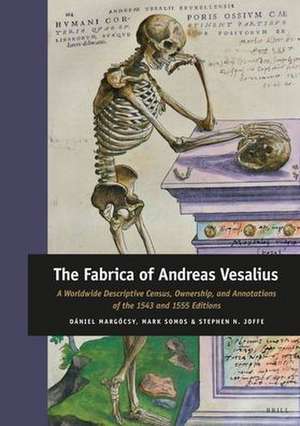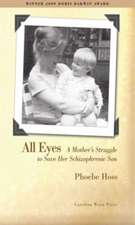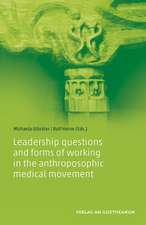The <i>Fabrica</i> of Andreas Vesalius: A Worldwide Descriptive Census, Ownership, and Annotations of the 1543 and 1555 Editions: Medieval and Early Modern Philosophy and Science, cartea 28
Autor Dániel Margócsy, Mark Somos, Stephen N. Joffeen Limba Engleză Hardback – 27 iun 2018
Additional background information
This book provides bibliographic information, ownership records, a detailed worldwide census and a description of the handwritten annotations for all the surviving copies of the 1543 and 1555 editions of Vesalius’ De humani corporis fabrica. It also offers a groundbreaking historical analysis of how the Fabrica traveled across the globe, and how readers studied, annotated and critiqued its contents from 1543 to 2017. The Fabrica of Andreas Vesalius sheds a fresh light on the book’s vibrant reception history and documents how physicians, artists, theologians and collectors filled its pages with copious annotations. It also offers a novel interpretation of how an early anatomical textbook became one of the most coveted rare books for collectors in the 21st century.
Din seria Medieval and Early Modern Philosophy and Science
- 18%
 Preț: 1026.13 lei
Preț: 1026.13 lei - 18%
 Preț: 667.77 lei
Preț: 667.77 lei - 18%
 Preț: 550.18 lei
Preț: 550.18 lei - 18%
 Preț: 682.61 lei
Preț: 682.61 lei - 18%
 Preț: 892.77 lei
Preț: 892.77 lei - 18%
 Preț: 897.36 lei
Preț: 897.36 lei - 18%
 Preț: 660.82 lei
Preț: 660.82 lei - 18%
 Preț: 870.98 lei
Preț: 870.98 lei - 18%
 Preț: 636.55 lei
Preț: 636.55 lei - 18%
 Preț: 633.06 lei
Preț: 633.06 lei - 18%
 Preț: 664.40 lei
Preț: 664.40 lei - 18%
 Preț: 678.68 lei
Preț: 678.68 lei - 18%
 Preț: 869.83 lei
Preț: 869.83 lei - 18%
 Preț: 584.93 lei
Preț: 584.93 lei - 18%
 Preț: 765.49 lei
Preț: 765.49 lei - 18%
 Preț: 852.67 lei
Preț: 852.67 lei - 18%
 Preț: 795.00 lei
Preț: 795.00 lei - 18%
 Preț: 671.40 lei
Preț: 671.40 lei - 18%
 Preț: 600.75 lei
Preț: 600.75 lei - 18%
 Preț: 804.36 lei
Preț: 804.36 lei - 18%
 Preț: 838.40 lei
Preț: 838.40 lei - 18%
 Preț: 752.05 lei
Preț: 752.05 lei - 18%
 Preț: 632.02 lei
Preț: 632.02 lei - 18%
 Preț: 656.43 lei
Preț: 656.43 lei - 18%
 Preț: 679.75 lei
Preț: 679.75 lei - 18%
 Preț: 683.66 lei
Preț: 683.66 lei - 18%
 Preț: 900.54 lei
Preț: 900.54 lei - 18%
 Preț: 719.00 lei
Preț: 719.00 lei - 18%
 Preț: 723.43 lei
Preț: 723.43 lei - 18%
 Preț: 716.19 lei
Preț: 716.19 lei
Preț: 1424.85 lei
Preț vechi: 1499.84 lei
-5% Nou
Puncte Express: 2137
Preț estimativ în valută:
272.73€ • 296.35$ • 229.24£
272.73€ • 296.35$ • 229.24£
Carte disponibilă
Livrare economică 31 martie-14 aprilie
Preluare comenzi: 021 569.72.76
Specificații
ISBN-13: 9789004336292
ISBN-10: 900433629X
Pagini: 475
Dimensiuni: 215 x 289 mm
Greutate: 2.2 kg
Editura: Brill
Colecția Brill
Seria Medieval and Early Modern Philosophy and Science
ISBN-10: 900433629X
Pagini: 475
Dimensiuni: 215 x 289 mm
Greutate: 2.2 kg
Editura: Brill
Colecția Brill
Seria Medieval and Early Modern Philosophy and Science
Cuprins
Acknowledgments
List of Illustrations
1 Introduction
1.1 Historical Background
1.2 Research Methods for the Census
1.3 Historiographical Intervention
2 A Valuable Book
2.1 Historical Price Analysis
2.2 Showcasing Ownership: Bindings
2.3 Decoration and Function: Hand-Colored Copies
3 Provenance
3.1 The Physician’s Book: Ownership between 1550–1650
3.2 The Jesuit Century: Ownership between 1650–1750
3.3 The Years of Change: Ownership between 1750–1850
3.4 Vesalius in America: Ownership between 1850–1950
3.5 The Global Fabrica: Ownership since 1950
4 Reading and Annotating the Fabrica: The Sporadic Reader4.1 The Typical Reader: A Case Study from Los Angeles
4.2 The Average Reader: A Frequency Analysis
4.3 Scribbling at the Front: Fashioning the Reader and the Author
4.4 Image and Text: Learning to See
4.5 Personal Experience and Bookish Learning
4.6 The Body in Parts: Generation and Control
4.7 Creating Order: Corrections, Errata, and Search Techniques
5 Censorship: Controlling Reading
5.1 Licensed Readers
5.2 Soul and Sex
6 Conclusion
Guide to the Catalogue
CATALOGUE
Australia
Austria
Belgium
Brazil
Bulgaria
Canada
China
Czech Republic
Denmark
Estonia
France
Germany
Hungary
Ireland
Israel
Italy
Japan
Mexico
The Netherlands
Norway
Poland
Portugal
Romania
Russia
Slovakia
Spain
Sweden
Switzerland
United Kingdom
United States
Argentina
Australia
Austria
Belgium
Canada
Czech Republic
Denmark
Finland
France
Germany
Hungary
Ireland
Israel
Italy
Japan
Latvia
Mexico
The Netherlands
New Zealand
Norway
Poland
Portugal
Romania
Russia
Slovenia
Spain
Sweden
Switzerland
Ukraine
United Kingdom
United States
1543 Editions
1555 Editions
1543 Editions
1555 Editions
Appendix
Bibliography
General Index
Index of Owners
Index of Places of Ownership
List of Illustrations
1 Introduction
1.1 Historical Background
1.2 Research Methods for the Census
1.3 Historiographical Intervention
2 A Valuable Book
2.1 Historical Price Analysis
2.2 Showcasing Ownership: Bindings
2.3 Decoration and Function: Hand-Colored Copies
3 Provenance
3.1 The Physician’s Book: Ownership between 1550–1650
3.2 The Jesuit Century: Ownership between 1650–1750
3.3 The Years of Change: Ownership between 1750–1850
3.4 Vesalius in America: Ownership between 1850–1950
3.5 The Global Fabrica: Ownership since 1950
4 Reading and Annotating the Fabrica: The Sporadic Reader4.1 The Typical Reader: A Case Study from Los Angeles
4.2 The Average Reader: A Frequency Analysis
4.3 Scribbling at the Front: Fashioning the Reader and the Author
4.4 Image and Text: Learning to See
4.5 Personal Experience and Bookish Learning
4.6 The Body in Parts: Generation and Control
4.7 Creating Order: Corrections, Errata, and Search Techniques
5 Censorship: Controlling Reading
5.1 Licensed Readers
5.2 Soul and Sex
6 Conclusion
Guide to the Catalogue
CATALOGUE
1543 Editions
Australia
Austria
Belgium
Brazil
Bulgaria
Canada
China
Czech Republic
Denmark
Estonia
France
Germany
Hungary
Ireland
Israel
Italy
Japan
Mexico
The Netherlands
Norway
Poland
Portugal
Romania
Russia
Slovakia
Spain
Sweden
Switzerland
United Kingdom
United States
1555 Editions
Argentina
Australia
Austria
Belgium
Canada
Czech Republic
Denmark
Finland
France
Germany
Hungary
Ireland
Israel
Italy
Japan
Latvia
Mexico
The Netherlands
New Zealand
Norway
Poland
Portugal
Romania
Russia
Slovenia
Spain
Sweden
Switzerland
Ukraine
United Kingdom
United States
Copies Sold at Auctions Since 1990
1543 Editions
1555 Editions
Private Copies
1543 Editions
1555 Editions
Appendix
Bibliography
General Index
Index of Owners
Index of Places of Ownership
Notă biografică
Dániel Margócsy, (PhD Harvard, 2009), is University Lecturer at the Department of the History and Philosophy of Science at the University of Cambridge. He is author of Commercial Visions: Science, Trade, and Visual Culture in the Dutch Golden Age (Chicago: University of Chicago Press, 2014).
Mark Somos (PhD Harvard, 2007; PhD Lugd. Bat., 2014) is Alexander von Humboldt Foundation Fellow at the Max Planck Institute for Comparative Public Law and International Law (Heidelberg), Senior Visiting Research Fellow at Sussex Law School, and Co-Editor-in-Chief of Grotiana.
Stephen N. Joffe, MBBCh (1967), MD (1976), was Professor of Surgery at University of Cincinnati. He has published multiple articles and textbooks on lasers in medicine and early anatomists.
Mark Somos (PhD Harvard, 2007; PhD Lugd. Bat., 2014) is Alexander von Humboldt Foundation Fellow at the Max Planck Institute for Comparative Public Law and International Law (Heidelberg), Senior Visiting Research Fellow at Sussex Law School, and Co-Editor-in-Chief of Grotiana.
Stephen N. Joffe, MBBCh (1967), MD (1976), was Professor of Surgery at University of Cincinnati. He has published multiple articles and textbooks on lasers in medicine and early anatomists.
Recenzii
"[...] this is a meticulously researched, engagingly written, and richly illustrated book that should appeal to historians of medicine as well as historians of the book."
- Kathleen Crowther (University of Oklahoma), Bull. Hist. Med., 2020, 94:294-295
"[...] it really should be on any shelves aiming to support study in the history of books, libraries, medicine, or art."
- David Pearson, University of London, in: Library & Information History, 35/2 (2019), pp 120-122
"[...] readers can see how the first great modern anatomical book becomes, across the centuries, a rare book for collectors, while maintaining valuable content for physicians and surgeons, historians of medicine and artists."
- Jacqueline Vons, in: Metascience [DOI: https://doi.org/10.1007/s11016-019-00464-4]
"This book is a high-quality publication, plentifully supplied with colour plates, graphs and maps to illustrate the authors’ findings. It is a very readable text and will be an invaluable resource for any Vesalius scholar. It will also have a broader appeal however, for anyone interested in how early modern books travel through time and space, or how early modern readers interacted with their texts."
- Richard W. Tait, Centre for Medieval and Renaissance Studies, Monash University, Australia, in: Endeavour, 10 December 2018
- Kathleen Crowther (University of Oklahoma), Bull. Hist. Med., 2020, 94:294-295
"[...] it really should be on any shelves aiming to support study in the history of books, libraries, medicine, or art."
- David Pearson, University of London, in: Library & Information History, 35/2 (2019), pp 120-122
"[...] readers can see how the first great modern anatomical book becomes, across the centuries, a rare book for collectors, while maintaining valuable content for physicians and surgeons, historians of medicine and artists."
- Jacqueline Vons, in: Metascience [DOI: https://doi.org/10.1007/s11016-019-00464-4]
"This book is a high-quality publication, plentifully supplied with colour plates, graphs and maps to illustrate the authors’ findings. It is a very readable text and will be an invaluable resource for any Vesalius scholar. It will also have a broader appeal however, for anyone interested in how early modern books travel through time and space, or how early modern readers interacted with their texts."
- Richard W. Tait, Centre for Medieval and Renaissance Studies, Monash University, Australia, in: Endeavour, 10 December 2018




